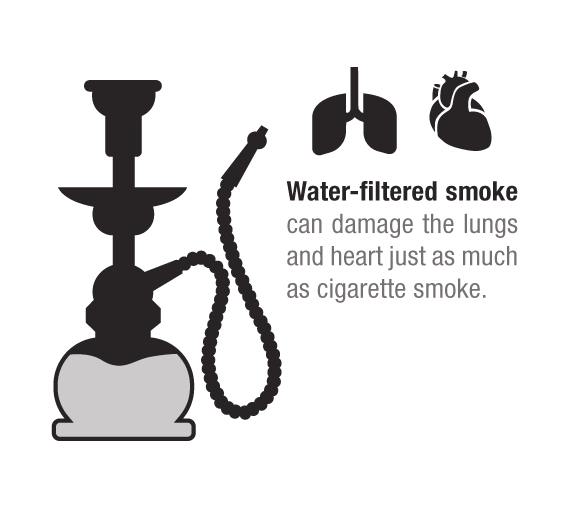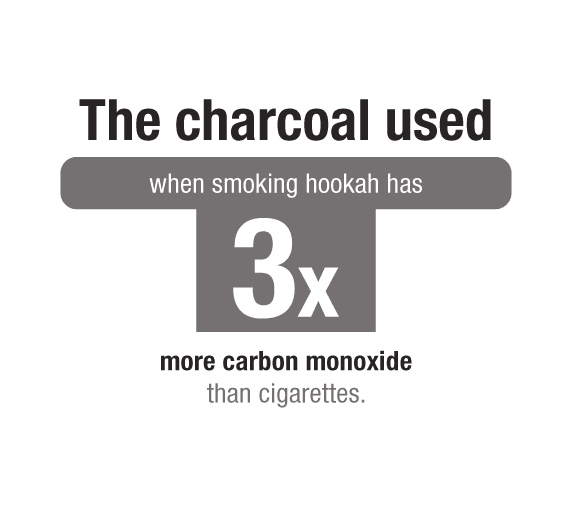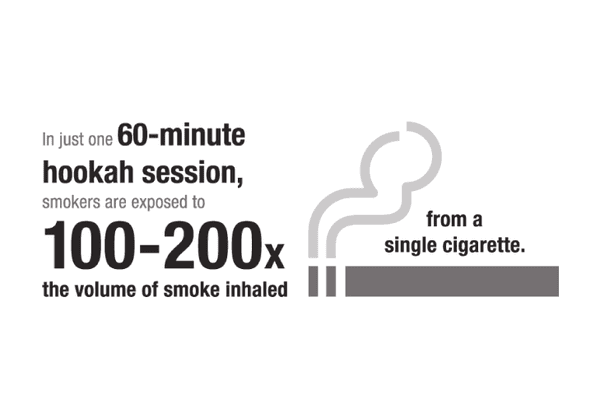The Harm and Health Effects of Hookah
Shisha? Hubbly-bubbly? Borry? Arhile? All of these terms refer to the hookah, a water pipe used to smoke tobacco. (Note: The term “hookah” is also used to describe the act of smoking one.) Hookah tobacco comes in various flavors, from fruity and sweet to minty and cool. In hookah shops and clubs, the fruity smell of flavored tobacco attracts young people, misleading them to believe hookah is a safe way to smoke tobacco. Hookah bars and lounges, where a communal hookah is placed in the center of each table, are also popular among college students and young adults. The social atmosphere surrounding hookah creates confusion about its safety. The truth, however, is that the danger of hookah is just as real as that of other tobacco products.
What is hookah?
Hookah has been around for centuries, but its popularity among American teenagers and young adults surged in the early 2000s. The allure of fruity flavors and the social ambiance of hookah bars and lounges contributed to its widespread appeal. A 2018 study found that 14.7% of college students had tried hookah. A separate study conducted by the Centers for Disease Control estimated that 590,000 high school students and 140,000 middle school students nationwide have as well. The younger someone starts using tobacco, the more likely it is to negatively impact their developing brains.
Hookah vs. cigarettes
Many people think hookahs are less harmful than traditional cigarettes. However, studies have shown that hookah smoke contains many of the same harmful chemicals and components found in cigarette smoke. Hookahs contain nicotine, just like cigarettes, which can cause a reliance on the substance. Compared with a single cigarette, smoking hookah for one hour delivers 25 times the tar, 125 times the smoke, 2.5 times the nicotine and 10 times the carbon monoxide. Hookah also contains high amounts of arsenic, lead and nickel.


Additionally, smoking tobacco through water does NOT filter out the cancer-causing chemicals. In fact, the water filtration process of hookahs requires users to take longer, harder drags. That means that, in the same 60-minute hookah session, a user inhales 100-200 times more smoke than they would from a cigarette, causing a larger strain on the lungs and esophagus.
Is hookah bad for you?
The short answer is yes. There are several health risks and negative side effects of hookah. Hookah smoke contains harmful substances, including nicotine, tar, carbon monoxide and toxicants. Nicotine can lead to a lifelong struggle with addiction, and the water filtration system of a hookah does little to prevent the harmful chemicals and additives from entering the respiratory system.
Hookah smoking is linked to the same health risks as cigarette smoking, such as:
- Lung cancer
- Oral cancers
- Bladder cancer
- Cardiovascular disease and clogged arteries
The long-term health risks of hookah include:
- Impaired lung function and breathing issues
- Chronic obstructive pulmonary disease
- Esophageal cancer
- Gastric cancer
- Decreased fertility
- Low birth weight
The short-term health risks include but are not limited to:
- Mouth irritation
- Labored breathing and reduced lung function
- Increased asthma attacks
- Coughing and wheezing
- Increased heart rate and blood pressure
- Carbon monoxide intoxication
For kids and teens, the dangers of hookah become even more severe. The human brain continues developing until age 25, with the fastest growth happening in the teen years. Although some hookah products are made with tobacco-free nicotine, they can still increase mood swings, irritability, anxiety, depression and learning difficulties.
Does hookah produce secondhand smoke?
Yes, hookah smoking can produce secondhand smoke, exposing non-smokers to the same harmful chemicals present in hookah smoke. Indoor hookah smoking, particularly in confined spaces like hookah lounges, can further exacerbate the issue, putting individuals at risk.

A gateway to addiction
For many people, especially for young people, hookah smoking is the first step toward addiction. Many people argue that the social nature of hookah make it less addictive and more difficult to access, but even infrequent and flavored hookah use can lead to a dependence on nicotine. While hookahs might be saved for social scenes, other flavored nicotine products, such as cigarillos, e-cigarettes, smokeless tobacco and nicotine pouches, are easy to purchase — spreading the dangers of hookah far beyond the lounge walls. Smoking hookah on a night out with friends is far from harmless when Big Tobacco has other products to make addiction accessible.
The allure of hookah, with its fruity flavors and communal settings, may lead many to believe it’s a safer alternative to cigarettes. However, the reality is very different. Hookah smoke contains harmful chemicals and toxicants, including nicotine, tar and carbon monoxide, with studies revealing that hookahs deliver significantly higher levels of these toxins compared to cigarettes. These misconceptions make the dangers of hookah even more severe for young adults, teens and even kids.
Learn more about the dangers of nicotine here. If you or someone you know is thinking about quitting tobacco, visit OKhelpline.com.











